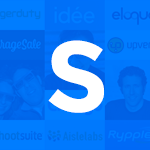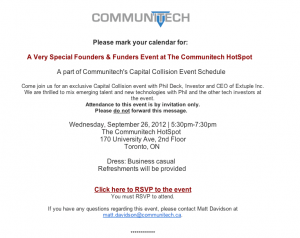I’m guessing this is confirmation that Waterloo Region is really just part of the Toronto ecosystem.



![]() Some rights reserved photo by nadiakushnir
Some rights reserved photo by nadiakushnir
I have seen The Communitech HubSpot space. Not a bad name given the facility that houses Communitech is called The Hub, calling a smaller zone in Toronto “The HubSpot” would make sense. Other than one of the leading CRM vendors based in Boston that has raised a combined $65MM in financing is also called HubSpot. That’s got to be bad for SEO.
I first saw the Communitech HubSpot space when I looked at moving the Maintenance Assistant offices earlier this year. It’s space located on the 2nd floor of 170 University Ave, that doubles as offices for Phil Deck. Phil was previously the CEO and Chairman of MKS Inc. which was acquired by PLC for $305MM in 2011. Phil is also on the Board at Communitech, which features other key players in the Waterloo and Toronto ecosystem including John Ruffolo of OMERS Ventures, Carol Leaman of Axonify, Ali Asaria of Well.ca and John Baker of Desire2Learn.
“It’s been a lot of hard work and even more fun putting Waterloo Region tech on the map with the help of a hugely supportive community.”
Iain Klugman, Communitech Marks 15 Year Anniversary of Supporting Waterloo Tech
It’s great news as Well.ca already has offices in Toronto. Previously Waterloo-based companies like Top Hat Monocle have moved to Toronto. There are a large number of Waterloo alums actively working in the Toronto startup ecosystem (I’m a UWaterloo alum along with Farhan Thawar, Zak Homuth, Zach Aysan, John Phillip Green, Dan Holowack, Oshoma Momoh, Bruce Chin, Garry Seto, Mike Rhemtulla, Monica Goyal and that’s just off the top of my head).
Too bad they chose to leverage an existing StartupNorth brand for the event. The least they could have done was invite us. Oh well, they stuck with our own “invite only” model.


